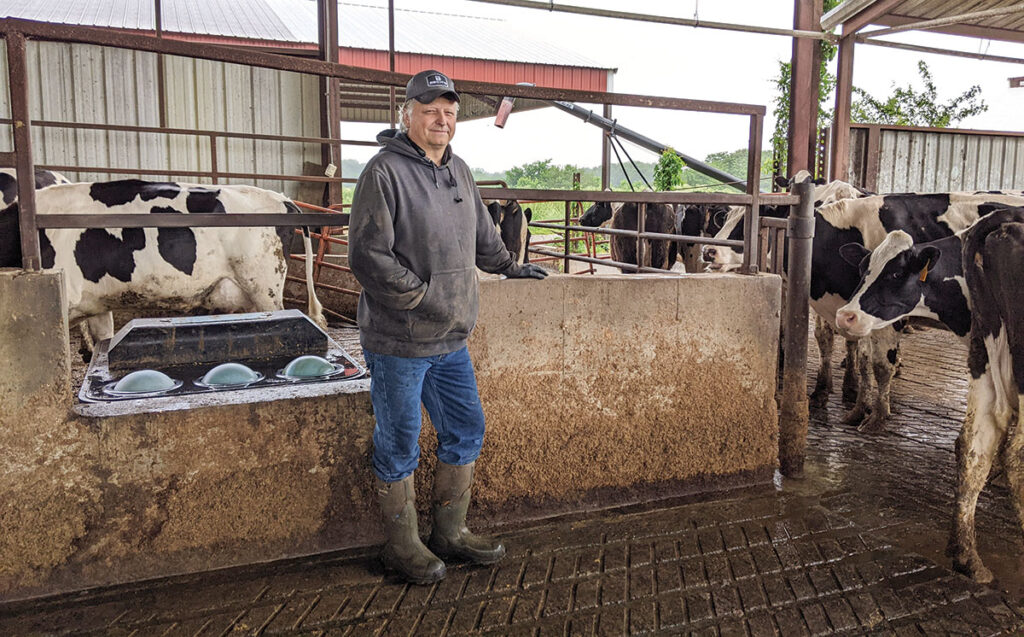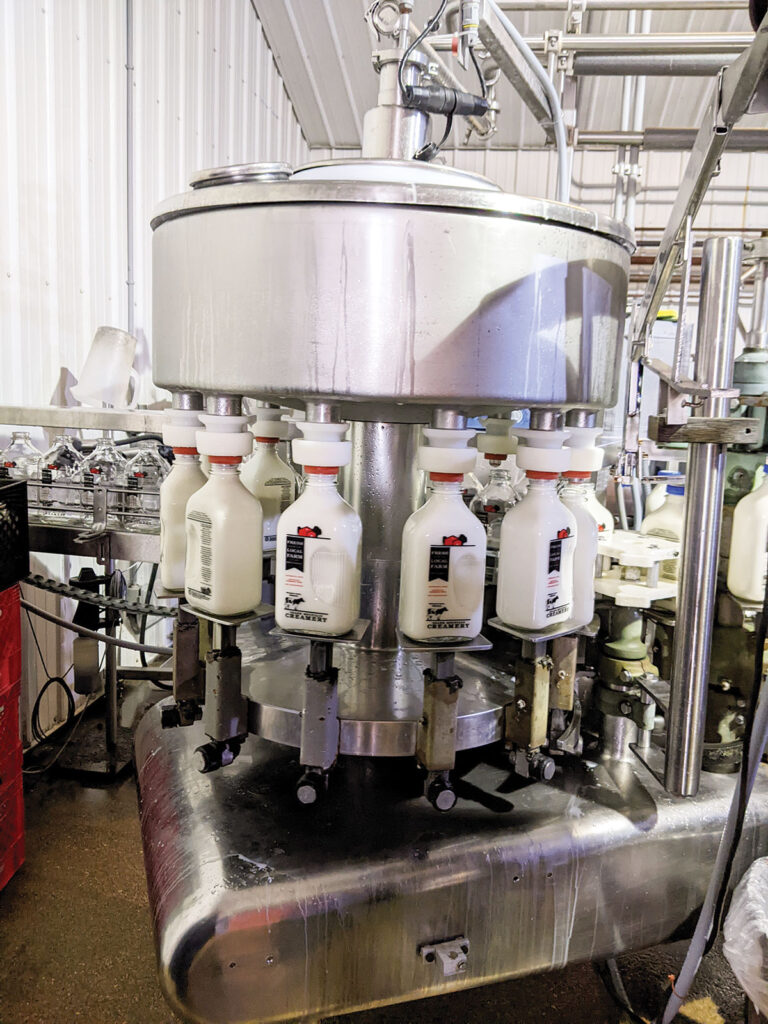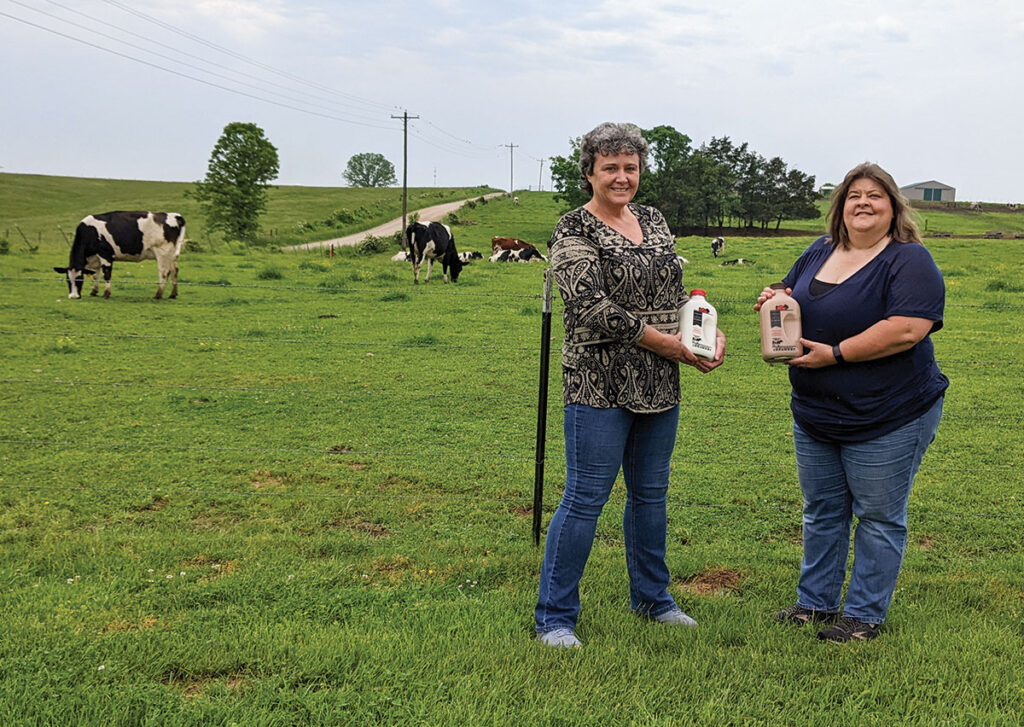
Ozark Mountain Creamery has grown since Fry Dairy began in 1957
MOUNTAIN GROVE, MO. – Carrying on the family tradition of dairy farming, brothers David and Dwight Fry and their families, of Mountain Grove, Mo., expanded Fry Dairy into the creamery business. Ozark Mountain Creamery milk stands out in the cooler with its unique glass bottle.
David’s wife Teresa and Dwight’s wife Lori run the creamery, while David and Dwight run the farm. In all, Ozark Mountain Creamery employs 12 people including Teresa and Lori. Three route drivers deliver the milk. Currently on its fourth generation of dairy farmers, the tandem business is all about family.
“The lucky part is my wife’s up at the creamery. My sons are right here; they’re milking. My brother comes and helps, he works with us. When my daughters were at home, they were in here milking at night. We all just work as a family,” Dwight said.
The original Fry Dairy was owned by Lloyd and Olva Fry. Their son Phillip, after returning home from WWII, helped Lloyd build the first Grade A dairy barn in Wright County. Phillip and Dora Fry began their own Fry Dairy in 1957 in the dairy’s present location. More milk barns were added (in 1990 and 2008) and after having run their father’s dairy, the brothers each milked in their own barns. David has recently retired from milking and Dwight’s sons, Luke and Caleb Fry, are now milking there.
“In 2009, the milk prices were really bad. We were brainstorming for ways for the farm to continue on and make ends meet. Dwight said, ‘We can either die a slow death like we’re doing now or we can jump in and either succeed or die a quick death,’” Teresa recalled. They built the creamery in 2009 and went into production in April 2010.
Prior to having the creamery, the Frys were running the dairy farm and selling milk to co-ops. They had sold to DFA and currently their excess milk goes to Central Equity Milk Co-op. The creamery sells an average of 4,000 gallons of milk a week, which constitutes about 75 percent of what is produced at the farm. The cows average 50 to 55 pounds of milk, per cow, per day according to Lori.
“They tend to give more milk,” Dwight said of their choice to have Holsteins. With dry cows and heifers, they have 140 head, with 90 to 100 coming through the double-eight herringbone parlor. They calve year round and use registered bulls as opposed to AI. Dwight milks mornings and weekend nights, and one of their employees comes in to milk on weeknights. “Her name is Lily Rogers and she does an excellent job.”
The farm 260 acres and the family raises the majority of their herd’s diet, which consists of corn, triticale and brome hay.
“We mix the commodity feed with our corn silage and our triticale and feed them TMR outside,” Dwight said. They purchase a commodity mix from Richards Brothers, which also run a grocery and was one of the first places to sell their milk. In the barn, the feed consists of ground corn, soybean meal and distillers grain.
“I went to the barn with my Dad when I was no more than 8 years old. My brother and I, we took care of calves. Once we got older we started buying calves. I was probably a senior in high school when I bought my first cow; I bought five. When my dad first retired, I bought his cows, about 20 of them,” said Dwight of his early start in dairy farming.
To keep the cows healthy, they vaccinate all of the cows about two weeks after they calve, and cows are dewormed before being dried off.
To protect the cows from the possibility of mold in the feed, they include BioBond in their diet.
In addition to milking and farming, David and Dwight help out at the creamery.
“If something breaks down, I make sure it gets fixed,” Dwight said.

Sometimes he oversees that a truck gets fixed or brings in a substitute truck to get the milk delivered. From the milk barn, the milk is hauled by truck to their creamery up the road.
“Every tank of milk brought up from the farm, goes through the lab,” Teresa said. From the receiving bay, it is tested for antibiotics and the butter fat level. The milk goes into one, large vat and it’s heated to 145 degrees for 30 minutes. Milk from larger processors generally is heated to a higher temperature for much less time.
At higher temperatures, more nutrients and enzymes in milk are destroyed. The Frys had planned on switching their pasteurization process to a quicker one, but Teresa explained that positive customer feedback swayed them to stay with the vat process. Some lactose intolerant customers reported they could tolerate Ozark Mountain Creamy milk. According to their website, they are one of only two dairies in the state that use the vat pasteurization method.
“When it’s in the vat, it gets up to 145 degrees,” Lori explained, adding it then gets cooled down in the plate cooler. “On one side is the hot milk and on the other side you have an ice cooler. It will chill it down from 145 degrees to when it goes in the tank, it’s about 40.”
There is a separator for the 2 percent milk and the skim milk. Using centrifugal force, the cream is separated from the milk. And all but the cream line milk passes through a homogenizer, to disperse the cream. Then the milk heads to the finishing tanks and bottler.
The glass bottles are filled, capped, date-stamped and placed in the cooler where Lori said it is stored between 32 and 38 degrees to keep the milk lasting longer.
“When they go out and make the deliveries, they pick up the empty glass bottles. We’ll have employees process them and get them ready to go through the bottle washer,” Teresa said. The bottle washer is a 1960’s model that is no longer made. “David and Dwight went through it from top to bottom and got it in shape. Farmers are good mechanics.”
In their first summer running the creamery as a family business, the prewashing of the bottles went to the kids who hand-cleaned them before they were run through the bottle washer.
They have since modified the system, so any empties needing rinsing, are tended to upon arrival. After going through the bottle washing machine, the bottles enter the processing room on a conveyor belt where employees inspect the bottles for cleanliness and cracks.
“The first bottling we did whole milk and chocolate. We did like a 100 gallons of each,” Lori said. They first sold milk locally in Mountain Grove through Richards Brothers and Country Mart. They gave out samples in the stores and appreciated the community’s kindness and encouragement. “Every other dairy farmer in the area came to taste our milk and support our farm. Everybody was excited for us,” said Teresa.
Ozark Mountain Creamery has added skim milk and cream line, and flavors are rotated throughout the year, including strawberry, orange cream, root beer, vanilla, butter pecan and eggnog. Of all of the flavored milks, Lori said eggnog wins. “It’s a definite holiday [favorite]. Everybody looks for eggnog.”
Ozark Mountain Creamery milk is sold to 148 locations. In addition to retail stores, coffee shops advertise using their milk and they also sell to schools and an assisted living facility.








